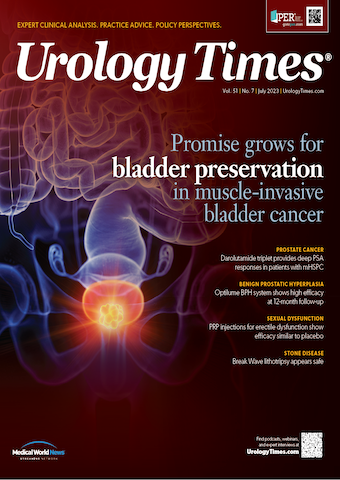Publication
Article
Urology Times Journal
Financial toxicity is a growing concern in urologic oncology
"Clinicians have opportunities to reduce patient subjective and objective financial burden if they continue to self-educate and communicate with patients and consider [financial toxicitiy] an adverse effect of treatment," write Alexandria A. Spellman, MD, MS, and Deborah R. Kaye, MD, MS.
Alexandria A. Spellman, MD, MS

The financial burden of cancer care experienced by patients is a growing concern. Health care costs are increasing, and a significant proportion of these costs is being shifted onto individual patients.1 The term financial toxicity (FT) describes the consequences of the direct (eg, costs of diagnosis and treatment) and indirect (eg, lost wages, parking and transportation expenses) costs of cancer care. FT encompasses not only an individual’s financial debt but also the psychological distress and coping mechanisms that ensue due to the financial burden.2 Patients with FT have decreased quality of life, higher treatment nonadherence, reduced spending on other life essentials, and overall worse health outcomes compared with those without FT.3
Deborah R. Kaye, MD, MS

FT is especially prevalent among patients with cancer.4 The cost of treating urologic cancers continues to increase due to an aging population, higher proportion of metastatic cancer cases, and the emergence of new and expensive treatments and diagnostic options.5-8 Urologic cancers are critical to consider when evaluating FT, as prostate, bladder, and kidney cancer are the second, fifth, and sixth most common malignancies, respectively, in the United States.9
About 15% to 20% of men with localized prostate cancer experience FT.10,11 Men who underwent external beam radiation therapy report worse FT than those who underwent radical prostatectomy or active surveillance.11 Younger patients (<65 years) are also at higher risk for FT.1,10,11 This could be secondary to worse or no insurance coverage and/or more indirect medical costs, such as lost wages, greater number of financial obligations (dependents), and less savings.1 Furthermore, men with more aggressive prostate cancer have more than twice the risk of FT compared with patients with less aggressive forms of prostate cancer.12 This is not surprising given that health care costs attributable to metastatic prostate cancer are $5.2 billion to $8.2 billion per year.13 New and expensive treatments are being introduced for the treatment of metastatic castrate-resistant prostate cancer. This has resulted in some patients paying high out-of-pocket payments.5 Similarly, for patients with metastatic hormone-sensitive prostate cancer, a recent study showed that among commercially insured patients, novel hormonal therapy (apalutamide [Erleada], abiraterone [Zytiga], enzalutamide [Xtandi]) posed significantly higher out-of-pocket costs than both androgen deprivation therapy and nonandrogenic systemic agents (docetaxel, cabazitaxel [Jevtana], and sipuleucel-T [Provenge]).14
Although prostate cancer has a higher incidence, bladder cancer is the most expensive malignancy to treat, due to the often-required long-term surveillance.15 Nearly a quarter of patients with bladder cancer experience significant FT.3,16 Noninvasive cancer at diagnosis, younger age, lower income, education level below a college degree, and either Medicare or lack of employer-sponsored health insurance are associated with worse FT.3,15,16 Importantly, among patients with bladder cancer, FT is a stronger predictor of reduced quality of life than disease stage and/or type of treatment.17 Further, some costs are variable and dependent upon clinician decision-making. One study demonstrated that physicians in the highest spending quartile spent up to 3 times more than clinicians in the lowest spending quartile with no differences in health outcomes. This highlights potential areas for payment reduction strategies.18
Of all genitourinary cancers, FT in renal cell cancer (RCC) is the least understood. As with prostate cancer, several expensive treatments have recently been introduced to treat metastatic RCC with large clinician-level variation.19 The high costs of new treatments and greater insurance cost-sharing can lead to significantly increased patient out-of-pocket payments.20 Like other cancers, high out-of-pocket costs for oral anticancer agents are associated with poor treatment adherence.6,21
Although we, as clinicians, are not directly in control of the costs of cancer care, we can take meaningful actions to mitigate this burden. Awareness, communication, regular screening for FT, and proactive referral to financial services and counseling may reduce financial burden and improve health outcomes.22
To promote awareness, we must be well informed about treatment costs and effectively communicate these costs to our patients. There is significant variation in treatment recommendations and payments among different clinicians and practices for treating the same condition, suggesting that clinician cost awareness can reduce patient out-of-pocket costs. Increased price transparency, where costs are publicly accessible, may also facilitate improved clinician awareness, but these mandates remain in flux. However, even without knowing exact costs, clinicians can reduce financial burden by not ordering tests or procedures that will not change management and/or outcomes and incorporating patients’ values into decision-making. Regularly revising and following updated guidelines, such as the revised American Urological Association microscopic hematuria guidelines (2020), also have the promise to decrease diagnostic and procedure volumes and significantly reduce total and per-patient costs.23 Clinicians should also be cognizant of the indirect costs of medical appointments, such as travel, time off from work, and child care, and recommend follow-ups only as necessary and in accordance with patient values. If able and/or appropriate, one can also consider telehealth visits.
Communication between clinicians and patients about direct and indirect treatment costs are essential. In a study of patients with metastatic cancer, only 28% of patients discussed cost of treatment with their clinician.24 Furthermore, only a quarter of clinicians feel comfortable discussing patient finances.25,26 Oncologists should be reassured that most patients desire cost discussions with their clinicians.27 Almost two-thirds of patients in a large bladder cancer study preferred that their physician review survival, adverse effects, and costs when discussing treatment preferences.15 Additionally, patients’ improved understanding of direct and indirect costs results in reduced FT.28 Patients should also be counseled about modifiable risk factors to help decrease cost of care; these include obesity and smoking, which can increase operative times, length of inpatient stay, and cause complications with resultant higher financial burden.29,30
Regular and recurrent screening for FT and early referral to financial counselors can also reduce FT.22 Although studies have identified certain risk factors associated with FT, all patients are susceptible and susceptibility can change throughout the course of treatment. Screening can be performed formally or informally. If identified, early acknowledgment and potential referral to financial counselors can mitigate financial distress.31-34
Altogether, FT is highly prevalent among patients with urologic cancer. Clinicians have opportunities to reduce patient subjective and objective financial burden if they continue to self-educate and communicate with patients and consider FT an adverse effect of treatment.
REFERENCES
1. Imber BS, Varghese M, Ehdaie B, Gorovets D. Financial toxicity associated with treatment of localized prostate cancer. Nat Rev Urol. 2020;17(1):28-40. doi:10.1038/s41585-019-0258-3
2. Altice CK, Banegas MP, Tucker-Seeley RD, Yabroff KR. Financial hardships experienced by cancer survivors: a systematic review. J Natl Cancer Inst. 2017;109(2):djw205. doi:10.1093/jnci/djw205
3. Messing EM. Financial toxicity of having bladder cancer. Bladder Cancer. 2018;4(3):351-352. doi:10.3233/BLC-189035
4. Gilligan AM, Alberts DS, Roe DJ, Skrepnek GH. Death or debt? National estimates of financial toxicity in persons with newly-diagnosed cancer. Am J Med. 2018;131(10):1187-1199.e5. doi:10.1016/j.amjmed.2018.05.020
5. Kaye DR, Lee HJ, Gordee A, et al. Medication payments by insurers and patients for the treatment of metastatic castrate-resistant prostate cancer. JCO Oncol Pract. 2023;19(4):e600-e617. doi:10.1200/OP.22.00645
6. Wilson LE, Spees L, Pritchard J, et al. Real-world utilization of oral anticancer agents and related costs in older adults with metastatic renal cell carcinoma in the United States. Kidney Cancer. 2021;5(3):115-127. doi:10.3233/KCA-210119
7. Kaye DR, Wilson LE, Greiner MA, et al. Patient, provider, and hospital factors associated with oral anti-neoplastic agent initiation and adherence in older patients with metastatic renal cell carcinoma. J Geriatr Oncol. 2022;13(5):614-623. doi:10.1016/j.jgo.2022.01.008
8. Desai MM, Cacciamani GE, Gill K, et al. Trends in incidence of metastatic prostate cancer in the US. JAMA Netw Open. 2022;5(3):e222246. doi:10.1001/jamanetworkopen.2022.2246
9. Siegel RL, Miller KD, Fuchs HE, Jemal A. Cancer statistics, 2021. CA Cancer J Clin. 2021;71(1):7-33. doi:10.3322/caac.21654
10. Joyce DD, Wallis CJD, Huang LC, et al. The association between financial toxicity and treatment regret in men with localized prostate cancer. JNCI Cancer Spectr. 2022;6(6):pkac071. doi:10.1093/jncics/pkac071
11. Stone BV, Laviana AA, Luckenbaugh AN, et al. Patient-reported financial toxicity associated with contemporary treatment for localized prostate cancer. J Urol. 2021;205(3):761-768. doi:10.1097/JU.0000000000001423
12. Kc M, Oral E, Rung AL, et al. Prostate cancer aggressiveness and financial toxicity among prostate cancer patients. Prostate. 2023;83(1):44-55. doi:10.1002/pros.24434
13. Olsen TA, Filson CP, Richards TB, Ekwueme DU, Howard DH. The cost of metastatic prostate cancer in the United States. Urol Pract. 2023;10(1):41-47. doi:10.1097/UPJ.0000000000000363
14. Joyce DD, Sharma V, Jiang DH, et al. Out-of-pocket cost burden associated with contemporary management of advanced prostate cancer among commercially insured patients. J Urol. 2022;208(5):987-996. doi:10.1097/JU.0000000000002856
15. Ehlers M, Bjurlin M, Gore J, et al. A national cross-sectional survey of financial toxicity among bladder cancer patients. Urol Oncol. 2021;39(1):76.e1-76.e7. doi:10.1016/j.urolonc.2020.09.030
16. Casilla-Lennon MM, Choi SK, Deal AM, et al. Financial toxicity among patients with bladder cancer: reasons for delay in care and effect on quality of life. J Urol. 2018;199(5):1166-1173. doi:10.1016/j.juro.2017.10.049
17. Catto JWF, Downing A, Mason S, et al. Quality of life after bladder cancer: a cross-sectional survey of patient-reported outcomes. Eur Urol. 2021;79(5):621-632. doi:10.1016/j.eururo.2021.01.032
18. Hollenbeck BK, Ye Z, Dunn RL, Montie JE, Birkmeyer JD. Provider treatment intensity and outcomes for patients with early-stage bladder cancer. J Natl Cancer Inst. 2009;101(8):571-580. doi:10.1093/jnci/djp039
19. Posadas EM, Limvorasak S, Figlin RA. Targeted therapies for renal cell carcinoma. Nat Rev Nephrol. 2017;13(8):496-511. doi:10.1038/nrneph.2017.82
20. Li P, Wong YN, Jahnke J, Pettit AR, Doshi JA. Association of high cost sharing and targeted therapy initiation among elderly Medicare patients with metastatic renal cell carcinoma. Cancer Med. 2018;7(1):75-86. doi:10.1002/cam4.1262
21. Dinan MA, Wilson LE, Greiner MA, et al. Oral anticancer agent (OAA) adherence and survival in elderly patients with metastatic renal cell carcinoma (mRCC). Urology. 2022;168:129-136. doi:10.1016/j.urology.2022.07.012
22. Kaye DR. Addressing financial toxicity in prostate cancer care. AUANews. October 1, 2022. Accessed May 31, 2023. https://bit.ly/43BAd5k
23. Gold SA, Kenigsberg AP, Lotan Y. Diagnostic and cost implications of the 2020 AUA microhematuria guidelines: modeling impact in a large public health care system. J Urol. 2022;207(1):52-60. doi:10.1097/JU.0000000000002175
24. Kelly RJ, Forde PM, Elnahal SM, Forastiere AA, Rosner GL, Smith TJ. Patients and physicians can discuss costs of cancer treatment in the clinic. J Oncol Pract. 2015;11(4):308-312. doi:10.1200/JOP.2015.003780
25. Howard DH, Bach PB, Berndt ER, Conti RM. Pricing in the market for anticancer drugs. J Econ Perspect. 2015;29(1):139-62. doi:10.1257/jep.29.1.139
26. Henrikson NB, Tuzzio L, Loggers ET, Miyoshi J, Buist DS. Patient and oncologist discussions about cancer care costs. Support Care Cancer. 2014;22(4):961-967. doi:10.1007/s00520-013-2050-x
27. Bullock AJ, Hofstatter EW, Yushak ML, Buss MK. Understanding patients' attitudes toward communication about the cost of cancer care. J Oncol Pract. 2012;8(4):e50-e58. doi:10.1200/JOP.2011.000418
28. Lentz R, Benson AB 3rd, Kircher S. Financial toxicity in cancer care: prevalence, causes, consequences, and reduction strategies. J Surg Oncol. 2019;120(1):85-92. doi:10.1002/jso.25374
29. Huynh MJ, Wang Y, Chang SL, et al. The cost of obesity in radical cystectomy. Urol Oncol. 2020;38(12):932.e9-932.e14. doi:10.1016/j.urolonc.2020.05.014
30. Mills E, Eyawo O, Lockhart I, Kelly S, Wu P, Ebbert JO. Smoking cessation reduces postoperative complications: a systematic review and meta-analysis. Am J Med. 2011;124(2):144-154.e8. doi:10.1016/j.amjmed.2010.09.013
31. Kline RM, Rocque GB, Rohan EA, et al. Patient navigation in cancer: the business case to support clinical needs. J Oncol Pract. 2019;15(11):585-590. doi:10.1200/JOP.19.00230
32. Shankaran V, Leahy T, Steelquist J, et al. Pilot feasibility study of an oncology financial navigation program. J Oncol Pract. 2018;14(2):e122-e129. doi:10.1200/JOP.2017.024927
33. Smith GL, Banegas MP, Acquati C, et al. Navigating financial toxicity in patients with cancer: a multidisciplinary management approach. CA Cancer J Clin. 2022;72(5):437-453. doi:10.3322/caac.21730
34. Yezefski T, Steelquist J, Watabayashi K, Sherman D, Shankaran V. Impact of trained oncology financial navigators on patient out-of-pocket spending. Am J Manag Care. 2018;24(suppl 5):S74-S79.


























